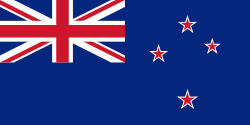Hawke's Bay Region (Hawke's Bay)
The region is situated on the east coast of the North Island. It bears the former name of what is now Hawke Bay, a large semi-circular bay that extends for 100 kilometres from northeast to southwest from Māhia Peninsula to Cape Kidnappers.
The Hawke's Bay Region includes the hilly coastal land around the northern and central bay, the floodplains of the Wairoa River in the north, the wide fertile Heretaunga Plains around Hastings in the south, and a hilly interior stretching up into the Kaweka and Ruahine Ranges. The prominent peak Taraponui is located inland.
Five major rivers flow to the Hawke's Bay coast. From north to south, they are the Wairoa River, Mohaka River, Tutaekuri River, Ngaruroro River and Tukituki River. Lake Waikaremoana, situated in northern Hawke's Bay, roughly 35 km from the coast, is the largest lake in Hawke's Bay, the fourth largest in the North Island and the 16th largest in New Zealand.
The regional council area consists of the territorial authorities of Wairoa District, Hastings District, Napier City, and its southernmost district, Central Hawke's Bay District, plus the localities of Taharua in the Taupo District and Ngamatea in the Rangitikei District. It does not include the Tararua District, Dannevirke, Woodville or Norsewood, which have been under the Manawatū-Whanganui Regional Council (also known as Horizons Regional Council) since the 1989 local government reforms. In June 2015, the Local Government Commission proposed the amalgamation of the four territorial authorities in the region with the Hawke's Bay Regional Council, but this was rejected in a poll of residents.
The region has a hill with the longest place name in New Zealand, and the longest in the world according to the 2009 Guinness Book of Records. Taumatawhakatangihangakoauauotamateaturipukakapikimaungahoronukupokaiwhenuakitanatahu is an otherwise unremarkable hill in southern Hawke's Bay, not far from Waipukurau.
Map - Hawke's Bay Region (Hawke's Bay)
Map
Country - New_Zealand
 |
 |
| Flag of New Zealand | |
The islands of New Zealand were the last large habitable land to be settled by humans. Between about 1280 and 1350, Polynesians began to settle in the islands and then developed a distinctive Māori culture. In 1642, the Dutch explorer Abel Tasman became the first European to sight and record New Zealand. In 1840, representatives of the United Kingdom and Māori chiefs signed the Treaty of Waitangi, which in its English version declared British sovereignty over the islands. In 1841, New Zealand became a colony within the British Empire. Subsequently, a series of conflicts between the colonial government and Māori tribes resulted in the alienation and confiscation of large amounts of Māori land. New Zealand became a dominion in 1907; it gained full statutory independence in 1947, retaining the monarch as head of state. Today, the majority of New Zealand's population of 5.1 million is of European descent; the indigenous Māori are the largest minority, followed by Asians and Pacific Islanders. Reflecting this, New Zealand's culture is mainly derived from Māori and early British settlers, with recent broadening of culture arising from increased immigration. The official languages are English, Māori, and New Zealand Sign Language, with the local dialect of English being dominant.
Currency / Language
| ISO | Currency | Symbol | Significant figures |
|---|---|---|---|
| NZD | New Zealand dollar | $ | 2 |
| ISO | Language |
|---|---|
| EN | English language |















